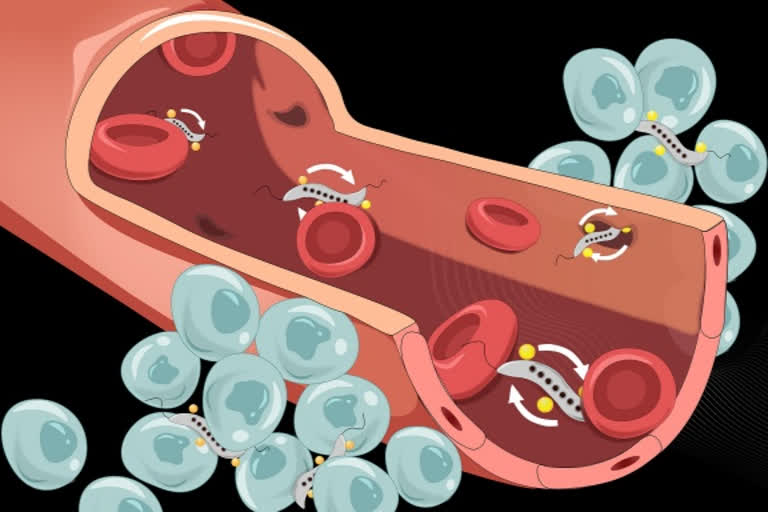Zurich [Switzerland]: Scientists all over the world are working to figure out how to get anti-cancer medications to the tumours that they are meant to treat. One idea is to use engineered bacteria as "ferries" to transport medications to tumours through circulation. ETH Zurich researchers have now successfully controlled some bacteria so that they can pass the blood vessel wall and invade tumour tissue.
The ETH Zurich researchers, led by Simone Schurle, Professor of Responsive Biomedical Systems, chose to experiment with bacteria that are naturally magnetic due to the iron oxide particles they contain. Magnetospirillum bacteria respond to magnetic fields and can be controlled by magnets outside the body.
Exploiting temporary gaps: Schurle and her colleagues have now demonstrated in cell cultures and animals that applying a rotating magnetic field to the tumour boosts the bacteria's capacity to pass the vascular wall near the malignant development. The spinning magnetic field drives the bacteria ahead in a circular manner at the vascular wall.
A closer examination is required to properly comprehend how the mechanism for crossing the vessel wall works: The blood vessel wall is made up of cells and acts as a barrier between the lifeblood and the tumour tissue, which is infiltrated by numerous small blood vessels. Certain chemicals may get through the vessel wall due to the narrow gaps between these cells. The cells of the vessel wall govern the size of these intercellular gaps, which can be temporarily broad enough to allow bacteria to pass through.
Strong propulsion and high probability: The ETH Zurich researchers demonstrated that pushing bacteria with a rotating magnetic field is efficient for three reasons using tests and computer simulations. For starters, rotating magnetic field propulsion is ten times more powerful than static magnetic field propulsion. The latter simply establishes the course, and the bacteria must proceed on their own. The second and most important reason is that germs are constantly moving along the vascular wall, propelled by the revolving magnetic field. When compared to other propulsion modes, where the bacteria's motion is less explorative, this makes them more likely to encounter the gaps that quickly occur between vessel wall cells. Third, unlike previous technologies, imaging is not required to track the microorganisms. The magnetic field does not need to be readjusted once it is placed over the tumour.
Also read: Study: Development of tools, techniques to explore tumor microenvironment
"Cargo" accumulates in tumour tissue: "We make use of the bacteria's natural and autonomous locomotion as well," Schurle explains. "Once the bacteria have passed through the blood vessel wall and are in the tumour, they can independently migrate deep into its interior." For this reason, the scientists use propulsion via the external magnetic field for just one hour - long enough for the bacteria to efficiently pass through the vascular wall and reach the tumour.
In the future, such microorganisms could transport anti-cancer medications. The ETH Zurich researchers emulated this application in cell culture studies by attaching liposomes (nanospheres of fat-like substances) to the bacterium. They labelled these liposomes with a fluorescent dye, allowing them to show in a Petri dish that the bacteria had delivered their "cargo" into the malignant tissue, where it accumulated. Liposomes would be loaded with medication for future medicinal use.
Bacterial cancer therapy: One of two ways bacteria can help in the fight against cancer is by acting as medication ferries. The other strategy, which has been around for almost a century, is based on the natural proclivity of specific types of bacteria to harm tumour cells. This could entail a number of processes. In any event, it is known that the bacteria trigger immune system cells, which then kill the tumour. Several research studies are actively looking into the effectiveness of E. coli bacteria against tumours. Today, microbes can be modified through synthetic biology to improve their medicinal impact, eliminate side effects, and make them safer.
Making non-magnetic bacteria magnetic: However, in order to exploit bacteria's intrinsic qualities in cancer therapy, the question of how these bacteria can efficiently reach the tumour must be addressed. While it is possible to inject the bacteria directly into tumours at the body's surface, it is not possible to do so for tumours deep within the body. Professor Schurle's micro robotic control comes into play here. "We hope our engineering technique can be used to improve the efficacy of bacterial cancer therapy," she says.
Because E. coli employed in cancer research is not magnetic, it cannot be driven or controlled by a magnetic field. Magnetic responsiveness is a fairly rare feature among microorganisms in general. Magnetospirillum is one of the few bacteria genera with this characteristic. As a result, Schurle hopes to make E. coli germs magnetic as well. This could one day allow a magnetic field to be utilised to regulate clinically employed medicinal microbes that lack natural magnetism. (ANI)
(This story has not been edited by ETV Bharat and is auto-generated from a syndicated feed.)



